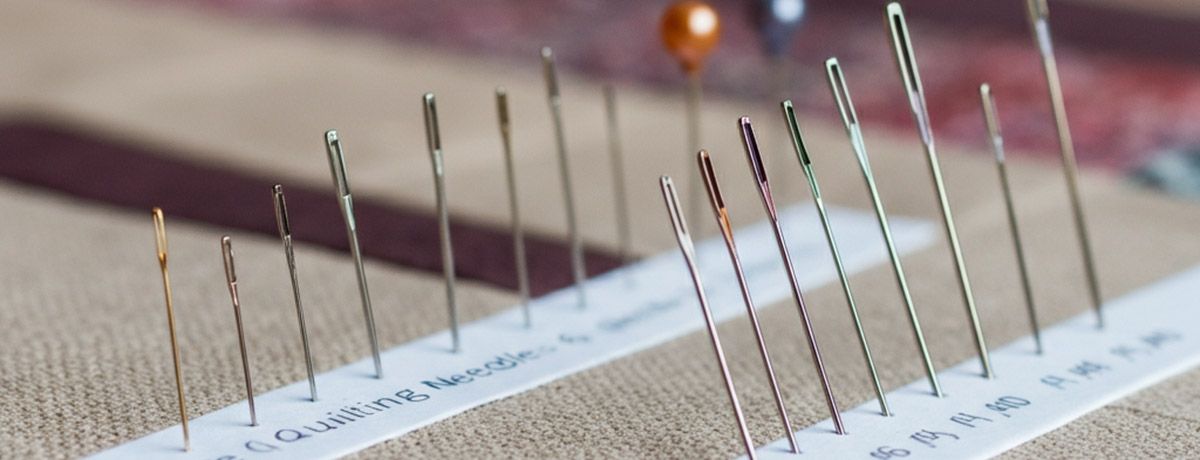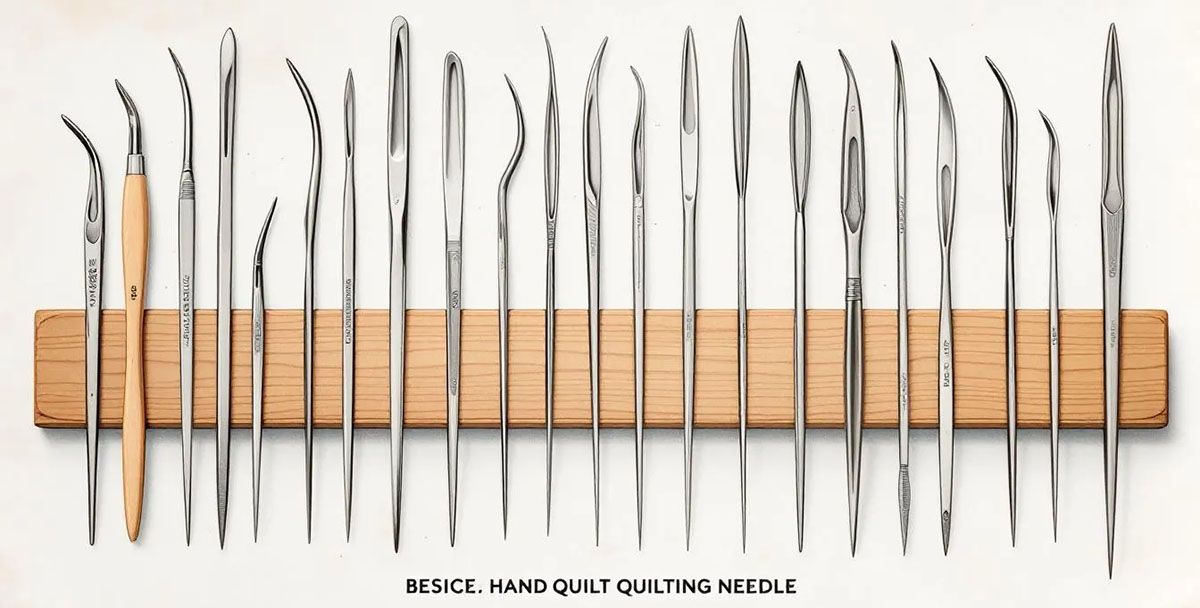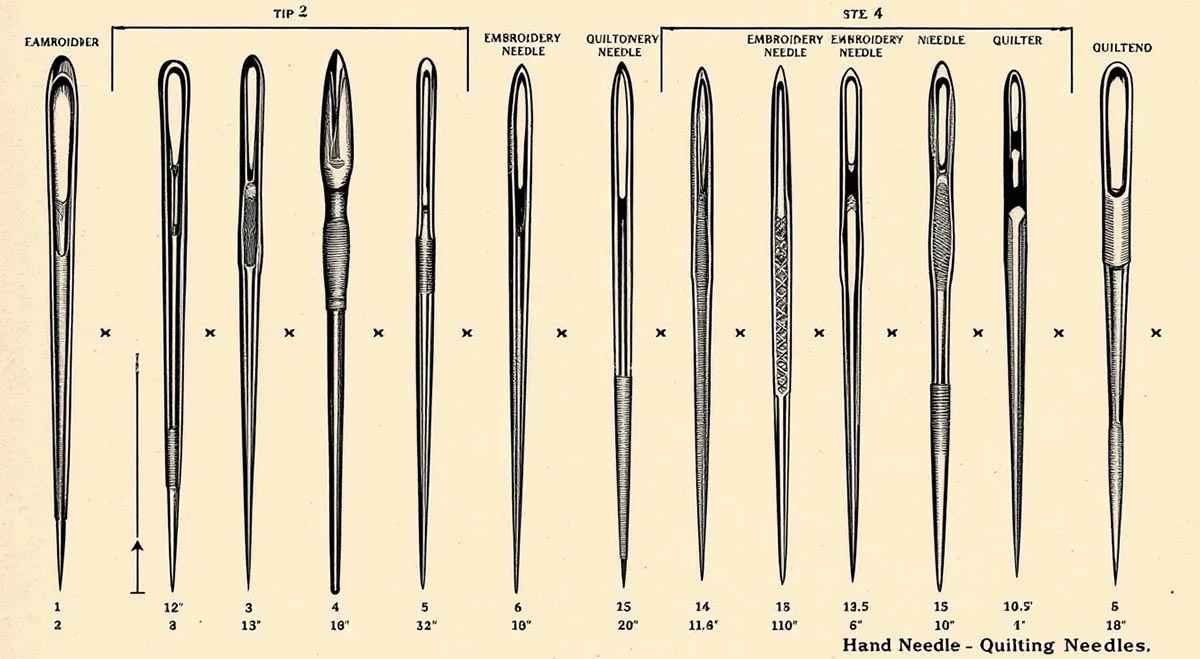Choosing the Right Hand Quilting Needle Size: Expert Tips for Perfect Stitches

Choosing the right hand quilting needle size ensures smooth stitching and a beautiful quilt. This guide covers the best needle sizes for different fabrics and projects.
Key Takeaways
-
Choosing the right hand quilting needle size is crucial for smooth stitching and high-quality quilts.
-
Different needle types, like quilting needles and embroidery needles, serve specific purposes for various quilting projects.
-
Regular needle maintenance and selecting the appropriate tools can enhance your quilting experience and lead to better results.
Understanding Hand Quilting Needle Sizes

Selecting the appropriate needle size for hand quilting ensures even stitching and improves the overall quilting experience. The right needle size greatly affects the quality of quilting, accommodating different fabric weights and types. Imagine trying to sew a delicate fabric with a large, thick needle; it would be like trying to thread a needle with a rope! The needle size should match the fabric thickness to ensure smooth stitching and prevent damage.
Choosing the right needle size directly impacts both the stitching process and the final look of the quilt. The appropriate needle size can significantly impact the quality and ease of sewing your quilt.
Matching the needle size to your fabric, whether lightweight or heavy-duty, makes hand sewing and hand quilting more enjoyable and efficient, especially when you choose to hand quilt.
The Basics: Common Types of Hand Quilting Needles

When it comes to hand quilting, not all needles are created equal. Different types of needles serve various purposes, each designed to tackle specific tasks:
-
Quilting needles (betweens)
-
Embroidery needles
-
Sharps
-
Milliners needles
-
Sashiko needles
Each type has its unique features that make it suitable for particular quilting projects.
Understanding these common types of hand quilting needles helps you select the right one for your next project.
Quilting Needles (Betweens)
Quilting needles, also known as betweens, are designed with a short length and a sharp point, making them ideal for traditional hand quilting. They are ideal for creating small, precise stitches necessary for a beautifully finished quilt. Different types of quilting needles include:
-
John James big eye quilting needles: feature a long narrow eye for easy threading.
-
Bohin needles: extremely sharp and easier to thread without bending.
-
Clover needles: reported to be difficult to thread but acclaimed for their sharpness.
A package of big eye hand quilting needles typically includes 20 needles, giving you plenty of options to work with. These needles are designed to glide smoothly through the quilt sandwich, which includes the top fabric, batting, and backing. The finer the needle, the easier it is to create even stitches without damaging the fabric. Whether you’re working on a small wall hanging or a large bedspread, quilting needles (betweens) are a staple in any hand quilter’s toolkit.
Various brands offer features that cater to specific needs. For example, John James needles are known for their longer eye, which makes threading a breeze, while Bohin needles are celebrated for their sharpness and ease of use. This idea highlights the importance of selecting the right straw needles for your projects.
Finding your favorite needle, whether it’s the precise Bohin or the easy to thread John James sewing machine, will enhance your quilting projects with hope. If you prefer a specific type, it can make a significant difference.
Embroidery Needles
A bigger eye characterizes embroidery needles and sharp points, making them suitable for thicker threads and multiple layers. These needles are commonly used for techniques such as French embroidery and are perfect for adding decorative stitches to your quilt. The larger eye allows for easy threading of thicker threads, like embroidery floss or perle cotton, which can add a beautiful texture and dimension to your quilting projects. An embroidery needle is an essential tool for achieving these effects.
Big eye hand quilting needles are useful for embroidery and other quilting techniques requiring thicker threads. Embroidery needles are versatile tools, suitable for big stitch quilting or adding intricate details to your quilt. Their sharp points easily penetrate multiple fabric layers without causing damage, making them excellent for various quilting projects.
Sharps
Sharps are a type of hand quilting needle designed for use with thicker fabrics. Key characteristics and uses include:
-
Typically range in size from 8 to 12, with smaller numbers indicating larger needles
-
Particularly useful for projects involving multiple layers of fabric or dense batting
-
Sharp points and sturdy construction make them ideal for piercing through thick materials without bending or breaking
Sharps needles are commonly used for quilting and sewing techniques requiring precision with thicker fabric layers. They are favored because:
-
They are reliable for heavy-duty quilts or projects with dense batting.
-
They can penetrate multiple fabric layers.
-
They are preferred by quilters working with various materials and thicknesses, including a sharp needle.
Milliners Needles
Milliners needles are beneficial for reducing fabric fraying because they create smaller holes. Originally designed for hat making, these needles have found their place in the quilting world due to their long length and round eye, which allows for easy threading of various thread types. Milliners needles are particularly useful for hand quilting techniques that require long, straight stitches, such as needle-turn appliqué or hand piecing.
Available in various sizes, these needles allow quilters to select the right one for their specific projects. For fine fabrics or thicker materials, there’s a milliners needle to suit your needs. Their long length is ideal for intricate quilting techniques, and the round eye makes threading easy, even with thicker threads.
Sashiko Needles
Sashiko needles are long and sturdy, equipped with small eyes to accommodate thicker threads, making them ideal for traditional Japanese quilting techniques. These needles are perfect for creating the distinctive running stitches that define sashiko quilting. Practice with sashiko needles on scrap fabric to get used to their length and the required thread tension for perfect stitches.
These hand sewing needles typically come in sizes that cater to varying thread thicknesses and fabrics, enabling quilters to choose the appropriate size for their project. Whether you’re working on a traditional sashiko quilt or incorporating sashiko techniques into your modern quilting projects, these needles will help you achieve beautiful, even stitches.
Their sturdier and precise design push them to be a glad and valuable addition to any quilting toolkit.
Choosing the Right Needle Size for Your Quilt Project
Choosing the right needle size ensures quality stitches and ease of use. The correct needle size significantly improves your quilting experience, whether with lightweight or heavy-duty fabrics. For needle size recommendations:
-
For lightweight fabrics, utilize size 9 or 10 needles.
-
For midweight fabrics, use size 10 or 11 needles.
-
For heavyweight fabrics, a size 12 needle is recommended.
The correct size and type of one needle reduce the risk of a bent or break during quilting with a new needle. This ensures a smooth and efficient stitching process, allowing you to focus on creating beautiful quilts.
Understanding how needle size impacts quilting helps you make decisions that enhance the quality and longevity of your projects.
Factors to Consider
The thickness of the quilt sandwich, which includes quilt layers and batting, is a significant factor that influences the choice of needle size. Consider the thickness of the quilt sandwich, including the top fabric, batting, and backing, when choosing the right needle size. Your personal stitching style, whether tight or loose, also affects the needle size you should select.
Needle sizes typically range from 60/8 to 100/16, with the needles size indicating the diameter; larger sizes accommodate thicker threads. Sashiko needles are favored for their sturdiness and ability to penetrate multiple fabric layers easily.
Considering these factors helps you choose a needle size that complements your quilting style and materials.
Matching Needle to Thread
Matching the needle to the thread weights is crucial to prevent thread breakage. The eye of the needle should be large enough to accommodate the thread without causing damage. Selecting the right needle eye size for the thread thickness prevents damage during stitching.
A needle with an eye that matches the regular thread thickness prevents breakage during quilting. Matching the needle to the thread, whether regular or thicker embroidery floss, ensures smooth stitching and reduces breakage. Careful matching enhances the overall quality of your quilting projects.
Testing and Adjusting
Testing various needle sizes on scrap fabric before starting ensures the desired stitch quality. Experimenting with multiple needle sizes on scrap fabric helps find the best fit for your quilting project. This helps identify the needle size that works best with your fabric and thread, ensuring smooth and even stitches.
Practicing with different needle sizes on fabric scraps helps identify the best option for a specific project. Testing and adjusting needle size before starting your main project helps avoid issues and achieve the best results. This extra step is well worth the time for the quality of your final quilt.
Maintaining Your Needles for Optimal Performance
Proper needle care involves:
-
Regularly replacing needles to ensure consistent stitch quality and prevent fabric damage.
-
Storing needles in a dry, cool place to preserve their sharpness and prevent rusting.
-
Maintaining needles properly to ensure optimal stitching performance and avoid issues during quilting.
Cleaning needles with a soft cloth after each session removes residue and improves performance. Taking care of your needles ensures they remain sharp and effective, making quilting projects smoother and more enjoyable.
Regular maintenance extends needle life and keeps your quilting experience frustration-free.
Essential Tools for Hand Quilting
Bohin needles are considered the gold standard in the quilting community. Bohin needles are preferred among trusted brands. Essential hand quilting tools significantly enhance the quilting experience and ensure better results.
Needle threaders, thimbles, and quilting hoop are essential tools that complement hand quilting needles. These tools make quilting projects more efficient and enjoyable. Needle threaders simplify threading, thimbles protect fingers, and quilting hoop maintain even tension across your quilt.
Investing in high-quality tools elevates your hand quilting experience and achieves beautiful, professional results for hand quilters.
Summary
Choosing the right hand quilting needle size is an essential step in achieving perfect stitches and a beautiful quilt. From understanding the importance of needle size to learning about the various types of needles and how to select the right one for your project, this guide has provided you with the knowledge you need. By maintaining your needles and using essential tools, you can enhance your quilting experience and create stunning quilts. Remember, practice makes perfect, so don’t hesitate to experiment and find what works best for you.
Frequently Asked Questions
Why is needle size important in hand quilting?
Needle size is super important because it directly impacts your stitch quality and makes sewing smoother, while also keeping your fabric safe from damage. Choosing the right size will make your hand quilting a lot easier and more enjoyable!
What are quilting needles (betweens) used for?
Quilting needles, or betweens, are your go-to for hand quilting because their short and sharp design makes it easy to create those tight, precise stitches. They're perfect for ensuring your quilts look professionally finished!
How do I choose the right needle size for my fabric?
To choose the right needle size, go for size 9 or 10 for lightweight fabrics, size 10 or 11 for midweight, and stick with size 12 for heavyweight fabrics. It's all about matching the needle to your fabric type for the best results!
Why should I match my needle to the thread weight?
You definitely want to match your needle to the thread weight to avoid thread breakage and ensure your stitching goes smoothly. It's just a smart move for better results!
How can I maintain my needles for optimal performance?
To keep your needles in top shape, replace them regularly, store them in a cool, dry place, and give them a quick wipe with a soft cloth after each use. It's an easy way to ensure they perform their best!
Contact MH
MH offer hand quilting needles, feel free to reach out to us for more details or inquiries. We're here to help!


